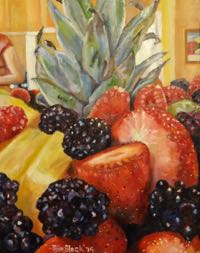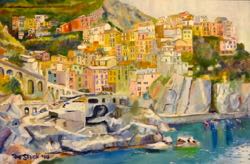
This is a demo I did of a still life in a recent class I taught. I always use a tinted canvas. I find that a white canvas doesn’t show color properly — it tends to create a pastel looking painting. I fill the canvas. I find the bottom of the scene, then figure where the top will fit, next I measure to see where everything else fits. I draw the scene quickly, then begin by painting the darkest darks and the lightest lights. Nothing can go darker or lighter than those. Next I begin looking for shapes and values. I don’t try to paint apples, but instead, look for shapes and values that might be on the apple. I put the shapes together, like a puzzle and they become an apple. I don’t mix colors, but paint pure colors. The right side of the rose might be light orange, but the left is a deep red. I do the same with the stem and leaves. Next I quickly paint a color in for the background and foreground to make sure it is right. This is the foundation of my still life painting technique, and it works very well for me.






Comments on Rose Demo
How fascinating to read your explanation. It’s almost like being there. Great job. I love your still lifes!
It sure does work well for you! I love the colors you use in this painting and, the subject matter, and your good explanation of how you go about painting a still life.
I am fascinated by your method! It makes so much sense to put in the colors you see separately. Getting those colored patches to form an object sounds like the tricky part to me. It seems like putting together a really difficult puzzle with a brush!
Tom, this is really nice. It is fascinating to me how you go about your craft. You have a method…that is true; at the same time, you have extreme talent. The combination results in your phenomenal work.
The painting you can tell was done very quickly and loosely, but the results are still amazing. Your explanation was one of the most interesting that I have read!